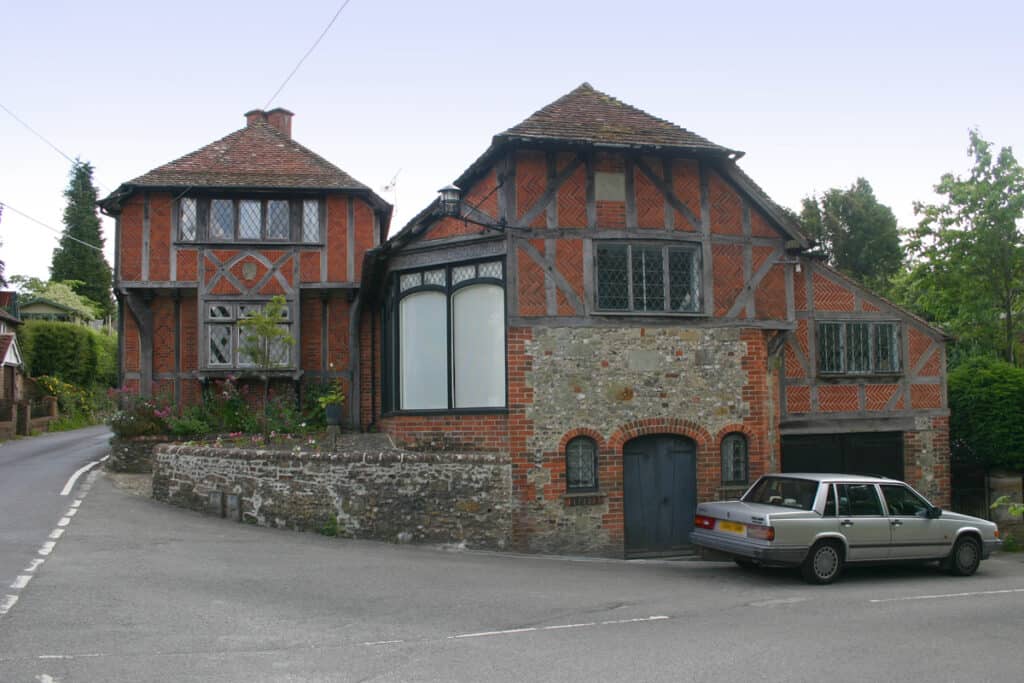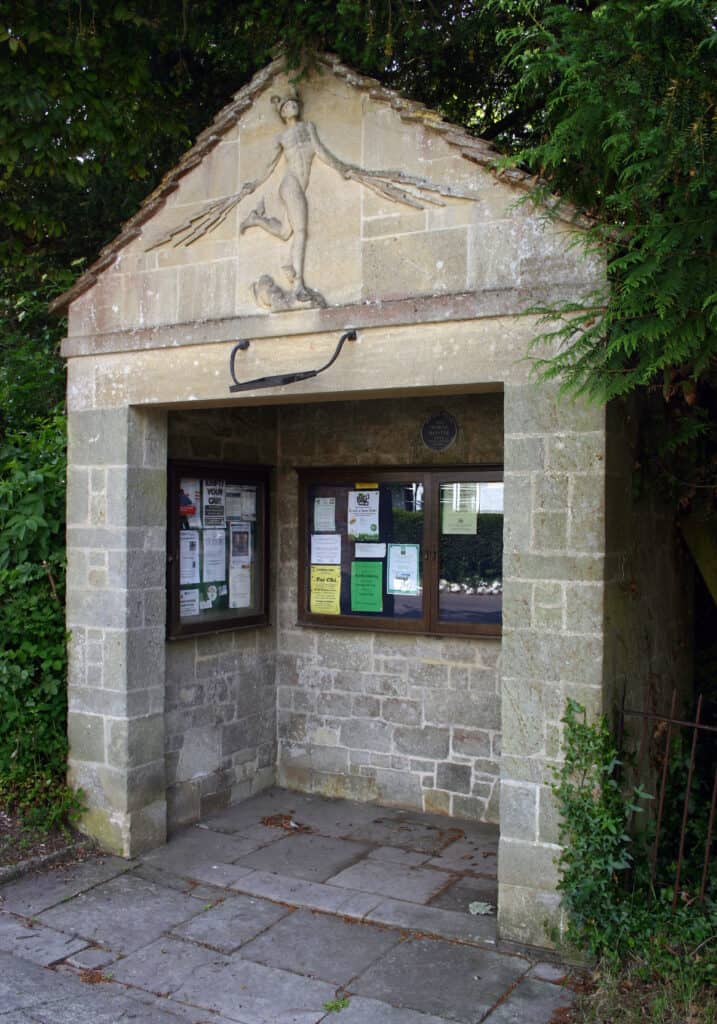By all accounts Bob was a simple fellow, known unkindly to the locals as the Village Idiot.
But a story I learned some years ago tells me he was not that much of an idiot after all.
Bob was standing outside Iwerne Minster village school one day when a car pulled up.
This was in the early 1930s, where there weren’t too many cars around.
The driver of this one wound down his window and asked for directions to Pimperne.

The former Co-operative Stores’ timber-framed design is typical of the Ismay era
Bob did his best to describe the route but after this third faltering attempt, the motorist’s irritation began to show.
‘My God, boy, you don’t know much, do you?’ he barked.
‘No, sir. But I baint’ lost,’ young Bob replied – a retort that ensured his place in village folklore.
I heard the tale back in 2010, when natives Jim Beck and Tom Crabbe took me on an historical tour of Iwerne Minster, which I reported in one of my regular columns in the original Blackmore Vale Magazine.
The school later became Clayemore School’s art and design department.
At the top of nearby Shute Lane, Jim and Tom showed me one of three surviving village pumps. I say ‘surviving’ because at one time there were four.
At this pump in the early 20th century, Iwerne’s last ‘Lord of the Manor’, James Ismay, used to display the daily papers for villagers to read.
‘Many people couldn’t afford newspapers but they could read the news at the pump,’ Jim told me.
Later the papers were displayed in a purpose-built shelter close by, which in its day was called the War Office (it opened during the First World War).
It is now known as the News Office and serves as the village notice-board.

The News Office, formerly known as the War Office
It looks rather like a bus shelter but I suspect you’d be waiting a long time for a bus in this village street.
A carving on the gable of Hermes, the Winged messenger, hints at the shelter’s original purpose.
James Ismay bought Iwerne Minster in 1908 and created a ‘model village’ atmosphere with hand-painted shop signs, various agricultural experiments and specially designed uniforms for the children.
He was a stickler for uniformity.
All the houses at roller-blinds supplied by the estate and villagers were not allowed to strip ivy off their walls.
The village boys wore blue jumpers with a red band while the girls had Little Red Riding Hood cloaks.
The previous squire, the second Lord Wolverton, also rang the changes, embarking on a building programme typified by the red brick half-timbered houses that are characteristic of Iwerne today.
Dating from the same era is Clayesmore School, designed for Lord Wolverton in 1878 by Alfred Waterhouse and described by leading architectural commentators Newman and Pevsner as ‘the most ambitious high Victorian mansion’ in Dorset.
Iwerne’s transformation was still going on when Sir Frederick Treves was writing his topographical classic Highways and Byways of Dorset in the early 1900s.
He was not overly impressed, but then it took a lot to impress the royal surgeon, who was never short of an opinion.
‘It [Iwerne] must at one time have been very picturesque, but it is in the process of being metamorphosed into red brick,’ wrote Sir Fred.
‘The low thatched cottages are gradually vanishing, to be replaced by bold houses of gaudy brick and tiles.’
In Treves’ view, just about the only thing going for these houses was that they were ‘hygienic’ – unlike the old cottages, which tended to be damp, poorly ventilated, with little natural light and limited sanitation.
‘The red brick house can claim to be “hygienic”, but by some ill fortune most things that are hygienic – whether they be clothing, food or buildings – are unpleasant and unsightly,’ Treves asserted.
‘Even the hygienic person, with his fusty undergarments, his dismal diet and his axioms about drains and traps, is not attractive.

Jim Beck (left) and Tom Crabbe pictured at the pump at the top of Shute Lane in 2010
‘It is unreasonable to require that the inhabitants of villages should occupy unwholesome dwellings merely to please the aesthetic tastes of the passer-by.
‘The exquisite old thatched cottage, with its tiny windows of diamond panes, must go, for the man of drains has spoken, and with it will vanish the most characteristic feature of rural England.’
Before the man of drains was the man of slops, but I doubt that Treves ever met Gulliver Wareham.
He was Iwerne’s very own toilet man but Mr Hygienic he was not.
Every Friday and Saturday, Wareham toured the village emptying slop pails into his pail cart.
Once a day he would wipe his hands down his shirt before eating his lunch.
He lived into his 90s.
Roger Guttridge




Hello Roger, I am in the process of constructing and discovering my family tree. Some of my ancestors come from Iwerne Minster and I would like to get in contact with Jim Beck and Tom Crabbe if at all possible to see if they could help.
in the census of 1851 George Roberts, my great x2 grandfather (born 1811 and married 1836) is listed as a baker.
his address is listerd as Iwerne Common, Iwerne Minster.
Thank in anticipation
Neil Roberts
Hello Neil
Sadly Roger is no longer with us, he passed away last year. You might want to contact the Iwerne Minster Parish clerk who may be able to help you with your research.
Kind regards
Courtenay